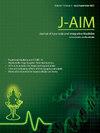Towards standardization of Prakriti Evaluation: A scoping review of modern assessment tools and their psychometric properties in Ayurvedic medicine
IF 1.9
Q3 INTEGRATIVE & COMPLEMENTARY MEDICINE
引用次数: 0
Abstract
Background
Ayurveda is an ancient Indian medical system that emphasizes individualized care based on the concept of Prakriti, which represents an individual's relative proportion of three doshas (humour) at the time of conception. Prakriti is believed to remain unchanged throughout one's life span, and based on the relative preponderance of doshas, it has been classified into ten types. Researchers and practitioners have developed various assessment tools, such as questionnaires, algorithmic and machine learning-based methods, and devices to bring objectivity and replicability to the Prakriti evaluation procedure. However, a systematic evaluation of their effectiveness and psychometric properties is currently lacking in the literature.
Objective
To identify Prakriti, classical Ayurveda texts suggest various techniques, but subjective variations and bias in interpretation have been reported among practitioners.
Methods
This scoping review aims to identify modern Prakriti assessment tools available in scientific literature and describe their psychometric properties to contribute to the development of more effective and standardized methods for Prakriti evaluation. Employing Arksey and O'Malley's five-stage methodological framework, the review critically assesses Prakriti evaluation tools, such as questionnaires, machine learning algorithms, and devices, to provide insights into the robustness and accuracy of these assessment methods.
Results
Thirty-two studies meeting the inclusion criteria were included in the review. Sixteen studies utilized questionnaires for Prakriti assessment, of which three were validated, six had established reliability, and three had both reliability and validity confirmed. Five studies employed algorithm-based methods, with three of these using validated machine learning models. Eleven studies utilized devices to assess Prakriti types, with only one device validated and providing access to data for reproducibility. Questionnaires were the most commonly used tools for Prakriti evaluation, followed by algorithm-based methods and devices.
Conclusion
Questionnaires are the most validated tools presently for Prakriti assessment despite their limited psychometric robustness. Machine learning based models show potential but suffers challenges in accuracy, replicability and finding the ground truth in a robust manner, and devices are the most objective assessment tools though none of them have been appropriately validated. Despite these limitations, Prakriti diagnosis is a promising field that requires robust procedures to establish standardized, replicable and reliable measures for its evaluation.
走向Prakriti评估的标准化:阿育吠陀医学中现代评估工具及其心理测量特性的范围审查
吠陀吠陀是一种古老的印度医疗体系,强调基于Prakriti概念的个性化护理,它代表了个体在受孕时三个doshas(幽默)的相对比例。Prakriti被认为在人的一生中保持不变,并且基于dosha的相对优势,它被分为十种类型。研究人员和实践者开发了各种评估工具,如问卷调查、算法和基于机器学习的方法,以及为Prakriti评估程序带来客观性和可复制性的设备。然而,目前文献中缺乏对其有效性和心理测量特性的系统评估。目的为了识别Prakriti,经典阿育吠陀文本提出了各种技术,但据报道,从业者在解释上存在主观差异和偏见。方法本综述旨在识别科学文献中可用的现代Prakriti评估工具,并描述其心理测量特性,以促进更有效和标准化的Prakriti评估方法的发展。本文采用Arksey和O'Malley的五阶段方法框架,对Prakriti评估工具(如问卷调查、机器学习算法和设备)进行了批判性评估,以深入了解这些评估方法的稳健性和准确性。结果32项符合纳入标准的研究被纳入综述。16项研究采用问卷进行Prakriti评估,其中3项研究得到验证,6项研究具有确定的信度,3项研究信度和效度均得到确认。五项研究采用了基于算法的方法,其中三项使用了经过验证的机器学习模型。11项研究使用了设备来评估Prakriti类型,只有一个设备得到验证,并提供了可重复性数据。问卷调查是Prakriti评估最常用的工具,其次是基于算法的方法和设备。结论问卷是目前最有效的Prakriti评估工具,尽管其心理测量稳健性有限。基于机器学习的模型显示出潜力,但在准确性、可复制性和以稳健的方式发现基础真相方面面临挑战,设备是最客观的评估工具,尽管它们都没有得到适当的验证。尽管存在这些限制,但Prakriti诊断是一个有前景的领域,需要强有力的程序来建立标准化、可复制和可靠的评估措施。
本文章由计算机程序翻译,如有差异,请以英文原文为准。
求助全文
约1分钟内获得全文
求助全文
来源期刊

Journal of Ayurveda and Integrative Medicine
INTEGRATIVE & COMPLEMENTARY MEDICINE-
CiteScore
4.70
自引率
12.50%
发文量
136
审稿时长
30 weeks
 求助内容:
求助内容: 应助结果提醒方式:
应助结果提醒方式:


